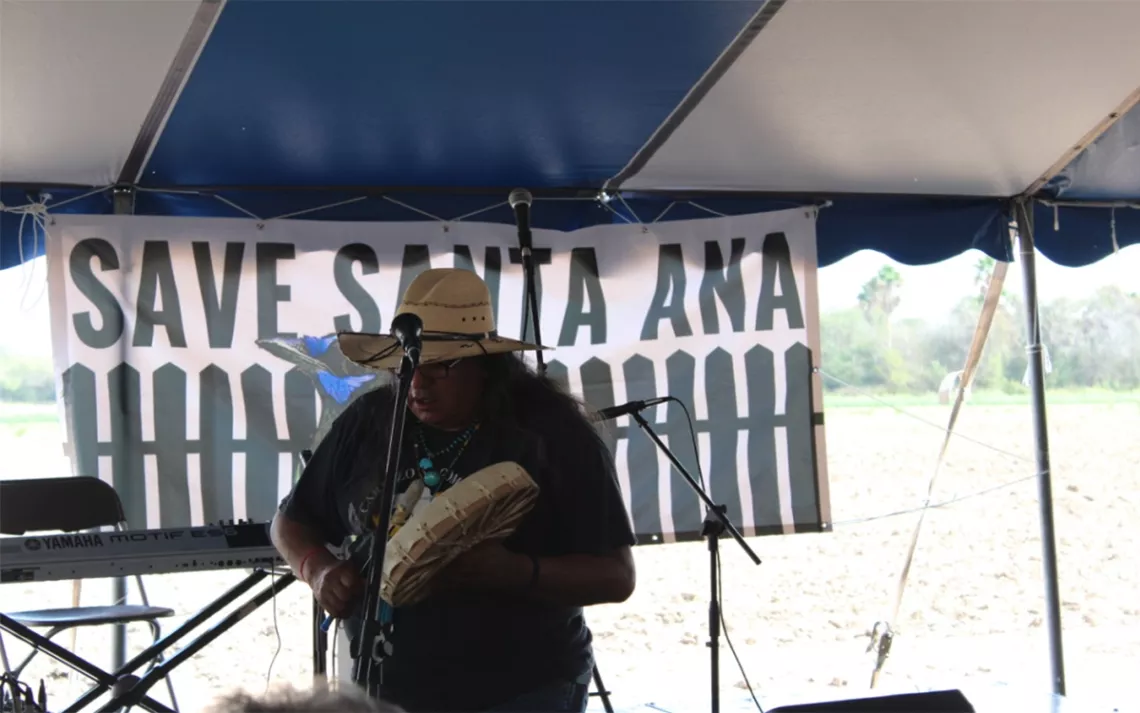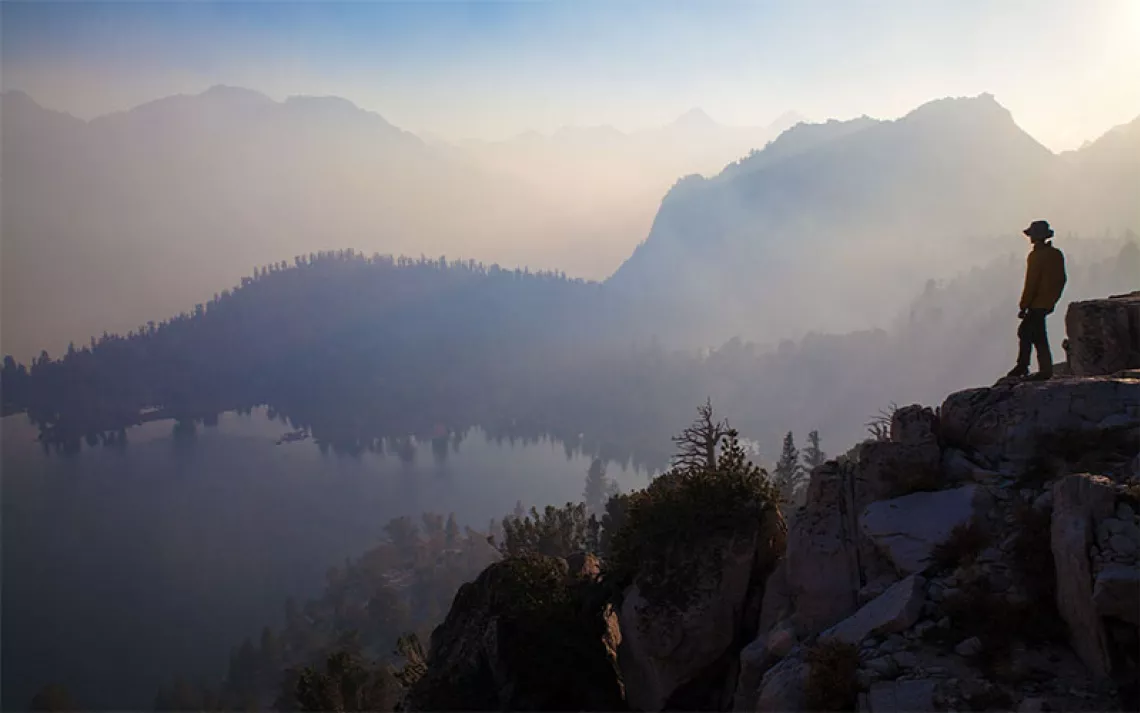Hundreds Rally to Oppose Border Walls, Support Clean Dream Act
Santa Ana is ground zero for fight to block destructive border wall

Photos by Daniel Blue Tyx
Hundreds of people gathered on Saturday to mark the 75th anniversary of the Santa Ana National Wildlife Refuge in Texas’s Rio Grande Valley, kicking off the rally with a cheering rendition of “Las Mañanitas,” the traditional Mexican birthday song. The atmosphere, however, was one of determined resistance, not celebration: The Trump administration has singled out the refuge as its first priority for border wall construction, and the future of immigrant Dreamers across the country remains in doubt.
A crowd of more than 600 gathered under a blue-and-white tent in a farmer’s field adjacent to Santa Ana, known as the “jewel of the national wildlife refuge system” for its ethereal landscapes of Spanish-moss-hung forests and the diversity of flora and fauna. Organized by a grassroots coalition including the immigrant-rights organization La Unión del Pueblo Entero (LUPE), the county Democratic Party, and the local Sierra Club chapter, the action projected a unified message from border residents: no border walls and a clean Dream Act.
“There’s this false narrative of our communities not being safe. The fact is we are already saturated with border security, and we live in one of the safest communities in the United States,” said Clarissa Riojas, a middle school teacher who helped organize the rally with the No Border Wall Coalition. “We’re here trying to elevate the voices of our community. We need a clean Dream Act that protects Dreamers and their families from deportation. And we need to prevent further militarization of border communities. We are not going to compromise. We need both things.”
Last fall, President Donald Trump announced that he would end the Deferred Action for Childhood Arrivals (DACA) program, which grants legal status to 800,000 young people brought to the United States as children. Since then, he has sought to extract funding for the “big, beautiful wall” he promised during the campaign by making its funding a precondition for any legislation that provides a pathway to citizenship for Dreamers. In January, congressional Democrats offered $1.6 billion in border wall funding—which would pay for 60 miles of new wall in the Rio Grande Valley and replace 14 miles of fencing in San Diego—in exchange for DACA legislation. President Trump rejected the proposal as not going far enough, laying the groundwork for a three-day government shutdown.
The Trump administration last week issued a waiver of 30 environmental laws for a 20-mile stretch of borderland in New Mexico. This followed a waiver issued last year for 37 laws in San Diego, currently being challenged in court as unconstitutional by a group that includes the Sierra Club, the Center for Biological Diversity, Defenders of Wildlife, and the State of California. The administration also issued a hard-line proposal that called for $25 billion in wall funding plus additional provisions that would block a pathway to citizenship for the parents and other relatives of immigrants, including the Dreamers.


Speaking to a crowd decked out in T-shirts that read “No Border Wall” and “Save Santa Ana,” U.S. representative Filemón Vela, whose district includes the Santa Ana refuge, said that he intends to hold Senate Minority Leader Chuck Schumer to his word that border wall funding should be “off the table.”
“The [Trump] administration from the very outset has attacked people of color, has attacked our ally, neighboring Mexico, and has attacked border communities,” he said. “How inhumane is it to pit our communities against each other and suggest that giving Dreamers a pathway to citizenship is a good idea but only if you spend $25 billion to construct a very, very ill-advised border wall?”
Vela suggested that the current impasse’s logical solution is an up or down vote on both the Dream Act and the border wall. “The Dream Act has no conditions that would require border wall funding,” he said. “If we have border security concerns that we need to address—and I personally disagree with the effort to fund the border wall—those votes ought to be taken separate and apart from any effort to provide Dreamers a pathway to citizenship.”
Several DACA recipients who spoke at Saturday’s rally amplified that message in stark personal terms. One of them was Allyson Duarte, a philosophy student at the University of Texas, Rio Grande Valley. “Being used as leverage to promote the border wall and nationalistic immigration policy is not only disempowering but dehumanizing,” she told the crowd. “Even though our lives are at stake, by no means are we willing to trade our protection for border wall funding.”
Santa Ana is first in line for border wall construction because it is federal land. That means it is not subject to time-consuming eminent domain proceedings. Geoffrey Hackett, president of the National Wildlife Refuge Association, an advocacy group of retired refuge managers, highlighted the devastating effects the wall would have on the refuge and other ecologically sensitive areas. “The Fish and Wildlife Service can’t always say what they think about things. I can,” he said. “This refuge is one of the places that most needs to be protected and preserved—not bisected by a wall that’s taller than the Wall of China. It makes absolutely no sense.”
Over 165,000 visitors come to Santa Ana each year, many drawn by the prospect of seeing dozens of tropical bird species not found anywhere else in the United States. Despite the 2,088-acre refuge’s diminutive size, more than 400 species of birds have been documented inside its boundaries—the second most in any refuge in the United States. This diversity makes it the premier destination for a $463-million annual eco-tourism industry in the Rio Grande Valley.
Standing outside the tent near a black-and-white “No Border Wall” banner, Bryan Bird, Southwest Program Director for Defenders of Wildlife, ticked off the list of harmful impacts of the wall. It would impede the migration of terrestrial animals like the endangered ocelot, create mammoth flooding concerns during not-infrequent hurricanes and tropical storms, clear more than 40 acres of pristine habitat, and potentially block access to most of the refuge for visitors. “We know the impacts that would happen here,” he said. “We know the Trump administration is targeting Santa Ana. Santa Ana is ground zero for this bigger fight that we’re taking from the Gulf of Mexico all the way to the Pacific.”
 The Magazine of The Sierra Club
The Magazine of The Sierra Club



